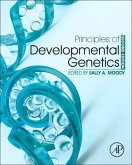Gene regulatory networks are the most complex, extensive control systems found in nature. The interaction between biology and evolution has been the subject of great interest in recent years. The author, Eric Davidson, has been instrumental in elucidating this relationship. He is a world renowned scientist and a major contributor to the field of developmental biology.
The Regulatory Genome beautifully explains the control of animal development in terms of structure/function relations of inherited regulatory DNA sequence, and the emergent properties of the gene regulatory networks composed of these sequences. New insights into the mechanisms of body plan evolution are derived from considerations of the consequences of change in developmental gene regulatory networks. Examples of crucial evidence underscore each major concept. The clear writing style explains regulatory causality without requiring a sophisticated background in descriptive developmental biology. This unique text supersedes anything currently available in the market.
The Regulatory Genome beautifully explains the control of animal development in terms of structure/function relations of inherited regulatory DNA sequence, and the emergent properties of the gene regulatory networks composed of these sequences. New insights into the mechanisms of body plan evolution are derived from considerations of the consequences of change in developmental gene regulatory networks. Examples of crucial evidence underscore each major concept. The clear writing style explains regulatory causality without requiring a sophisticated background in descriptive developmental biology. This unique text supersedes anything currently available in the market.
"The Regulatory Genome offers evo-devo aficionados an intellectual masterpiece to praise or to pan but impossible to ignore. Although there is clearly still much to learn about the evolution of gene networks and how these in turn constrain evolution, Davidson has placed a cornerstone for the comparative analysis of gene regulatory networks. Further research in this rather fresh field promises to help delineate the links between development and evolution." --Detlev Arendt, Developmental Biology Programme, European Molecular Biology Laboratory, Germany in SCIENCE
"...a highly informative book, provocative in the best sense of the word, and very much at the forefront of the field of developmental biology in the 'post-genomic' era. I recommend it highly to anyone interested in the subject." --Igor B. Dawid, Laboratory of Molecular Genetics, National Institute of Child Health and Human Development, NIH, in THE FASEB JOURNAL
"...Davidson does an excellent job of reducing the complexity of different developmental pathways and modes of embryonic development in diverse animal phyla to a set of simplified and logical concepts and principles. He provides excellent illustrations and experimental examples derived from several model organisms: nematode worms, fruitflies, sea urchins, tunicates and vertebrates of different sorts. What is especially attractive about the book are the regulatory networks drawn as simple wiring and computational diagrams. These go a long way towards explaining the basic regulatory logic and engineering principles of some of the most complex biological phenomena: animal development and the evolution of body forms.
This book should be read by all biologists who want to understand how development and evolution take place and what governs the workings of genomes. I also recommend it to computer scientists and engineers who are interested in the budding field of computational biology, as reading it does not require an extensive background in developmental biology." --Michael Karin, University of California San Diego School of Medicine, in NATURE
"Every step of [Eric Davidson's] logic is presented with examples to explain his idea, with beautiful, well-designed color figures. His concept of the significant roles of gene regulatory networks in development and evolution can be clearly understood using the aforementioned key terms....I strongly recommend this book to young scientists with multidisciplinary talents, who will advance the author s idea of the regulatory genome into its next phase, a voyage into the sea of genome complexity...reading this book is a pleasure, as it allows us to touch the incredible spirit of a very tough scientist. Davidson has developed his idea of the gene regulatory network in development and evolution for more than 35 years and has raised it finally to the level of a real paradigm." --Nori Satoh, Department of Zoology, Kyoto University, Japan, in NATURE GENETICS
"Prof. Davidson achieves a remarkable synthesis of key concepts in genomics, embryology, and evolutionary biology. He makes a persuasive case for the importance of regulatory networks in revealing the logic of complex developmental processes. The book is at the cusp of traditional disciplines in the biological sciences and the emerging field of computational biology. We finally have a book that reduces complex phenomena to basic principles, and then describes how these principles can explain among the most remarkable phenomena in nature: animal development and evolution." --Mike Levine, University of California, Berkeley, U.S.A.
"...a highly informative book, provocative in the best sense of the word, and very much at the forefront of the field of developmental biology in the 'post-genomic' era. I recommend it highly to anyone interested in the subject." --Igor B. Dawid, Laboratory of Molecular Genetics, National Institute of Child Health and Human Development, NIH, in THE FASEB JOURNAL
"...Davidson does an excellent job of reducing the complexity of different developmental pathways and modes of embryonic development in diverse animal phyla to a set of simplified and logical concepts and principles. He provides excellent illustrations and experimental examples derived from several model organisms: nematode worms, fruitflies, sea urchins, tunicates and vertebrates of different sorts. What is especially attractive about the book are the regulatory networks drawn as simple wiring and computational diagrams. These go a long way towards explaining the basic regulatory logic and engineering principles of some of the most complex biological phenomena: animal development and the evolution of body forms.
This book should be read by all biologists who want to understand how development and evolution take place and what governs the workings of genomes. I also recommend it to computer scientists and engineers who are interested in the budding field of computational biology, as reading it does not require an extensive background in developmental biology." --Michael Karin, University of California San Diego School of Medicine, in NATURE
"Every step of [Eric Davidson's] logic is presented with examples to explain his idea, with beautiful, well-designed color figures. His concept of the significant roles of gene regulatory networks in development and evolution can be clearly understood using the aforementioned key terms....I strongly recommend this book to young scientists with multidisciplinary talents, who will advance the author s idea of the regulatory genome into its next phase, a voyage into the sea of genome complexity...reading this book is a pleasure, as it allows us to touch the incredible spirit of a very tough scientist. Davidson has developed his idea of the gene regulatory network in development and evolution for more than 35 years and has raised it finally to the level of a real paradigm." --Nori Satoh, Department of Zoology, Kyoto University, Japan, in NATURE GENETICS
"Prof. Davidson achieves a remarkable synthesis of key concepts in genomics, embryology, and evolutionary biology. He makes a persuasive case for the importance of regulatory networks in revealing the logic of complex developmental processes. The book is at the cusp of traditional disciplines in the biological sciences and the emerging field of computational biology. We finally have a book that reduces complex phenomena to basic principles, and then describes how these principles can explain among the most remarkable phenomena in nature: animal development and evolution." --Mike Levine, University of California, Berkeley, U.S.A.








